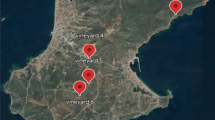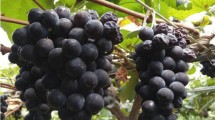Abstract
Anatolia is one of the most important main gene centers of V. vinifera grapes in the world. Although The Black Sea Region has a fairly wide geographic area in Turkey, the European grapes are the least grown in this region except for V. labrusca grapes. Because of the having heavy rainfall in both spring and autumn of the region, when combined with insufficient sunshine during the vegetation period, V. vinifera cultivars are not be grown economically in this humid northern area. Samsun city is settled in the Black Sea region, and has two important agricultural plains. Although Samsun settled in this humid region, it has the least rainfall compared to other coastal provinces towards the Eastern Black Sea Region. In this study, the adaptation of some wine grapes (Vitis vinifera L.) in Samsun conditions is evaluated by examining the phenology and ripening characteristics of ‘Merlot’, ‘Cabernet Sauvignon’, ‘Syrah’, ‘Ugni Blanc’, ‘Kalecik Karası’, ‘Muscat’ and ‘Chardonnay’grapes from 2014 to 2016. Some different climatic indices were used to assess the potential of wine grape cultivars grown in this region. In the study, grapes were evaluated whether will grow or not suitable in this location by using Winkler Index (WI), Huglin Index (HI), Branas Heliothermic Index (BHI), and Hydrothermic Index (Hyl). When the climatic indices evaluated according to long term climate records; Huglin index 1983; Winkler index 1848; Branas Hyl 3991, and Heliothermic index were found as 3.5 oC. According to average values of 2014, 2015, and 2016 years; the Huglin index 2290; Winkler index 2132; Branas Hyl index 5198, and Heliothermic index was determined as 3.8 oC. The phenological investigations and the evaluated climatic records showed that the research area is very favorable to grow wine grapes. According to Hyl results, moderate fungal disease risk might be considered for the central coastal area of the Samsun region.





Similar content being viewed by others
References
Amerine MA, Winkler AJ (1944) Composition and quality of musts and wines of California grapes. Hilgardia 15:493–675
Bahar E, Korkutal İ, Öner H (2018) Bağcılıkta Terroir Unsurları. Bahçe 47:57–70
Becker NJ (1977) The influence of geographical and topographical factors on the quality of the grape crop. In: Proceedings of the OIV symposium on quality of the vintage. Oenological and viticulture research institute, Capetown, pp 169–180
Becker N, Zimmermann H (1984) Influence de divers apports d’eau sur des vignes en pots, sur la maturation des sarments, le développement des baies et la qualité du vin. Bull OIV 57:584–596
Blanco-Ward D, Queijeiro JG, Jones GV (2007) Spatial climate variability and viticulture in the Miño River Valley of Spain. Vitis 46:63–70
Bois B, Wald L, Pieri P, Van Leeuwen C, Commagnac L, Chery P, Christen M, Gaudillère JP, Saur E (2008) Estimating spatial and temporal variations in solar radiation within Bordeaux winegrowing region using remotely sensed data. J Int Sci Vigne Vin 42:15–25
Branas J (1974) Viticulture. Déhan, Montpellier
Branas J, Bernon G, Levadoux L (1946) Eléments de viticulture générale. Dehan, Montpellier
Brown MV, Moore JN, McNew RW, Fenn P (1999) Inheritance of downy mildew resistance in table grapes. J Am Soc Hortic Sci 124:262–267
Çağlak S, Özlü T, Toy S (2019) İklim Verilerinin Deniz Etkisi Altında Kentsel Kırsal Farklılığı, Samsun Kenti Örneği. Iğdır Üniv Fen Bilim Enst Derg 9:330–338
Candemir F, Özdemir N (2010) Samsun province land resources and soil problems. Anadolu J Agric Sci 25:223–229
Cangi R (1999) Research to determine the ampelographic characteristics of grape varieties grown in Ordu. In: IIIrd National Horticultural Congress Ankara, Turkey, 14–17 September (in Turkish)
Cangi R, Çelik H, Köse B (2006) Determination of ampelographic characters of some natural foxy grape (Vitis labrusca L.) types grown in Northern Turkey (Ordu and Giresun Province). Int J Bot 2:171–176
Çelik S (2007) Bağcılık (Ampeloloji), 2nd edn. Avcı Ofset, İstanbul, TR, p. 428
Çelik H, Ağaoğlu YS, Fidan Y, Marasalı B, Söylemezoğlu G (1998) General viticulture. Sun Fidan, Ankara
Çelik H, Köse B, Cangi R (2008) Determination of foxy grape genotypes (Vitis labrusca L.) grown in Northeastern Anatolia. Hortic Sci 4:162–170
Çelik H, Odabaş F, Köse B, Cangi R (2009) Samsun’da yetişmekte olan İzabella (Vitis labrusca L.) üzüm tiplerinim ampelografik özelliklerinin belirlenmesi. In: 7. Türkiye Bağcılık ve Teknolojileri Sempozyumu, pp 5–9
Chevet JM, Lecocq S, Visser M (2011) Climate, grapevine phenology, wine production, and prices: Pauillac (1800–2009). Am Econ Rev 101:142–146
Dengiz O, Sarıoglu FE (2011) GIS analysis for topographic properties with some land properties and land use in Samsun province. Ege Üniv Ziraat Fak Derg 48:55–60
Durmus E, Yigit A (2003) The fruit producing regions of Turkey. Fırat Univ J Soc Sci 13:23–54
Falcao LD, Burin VM, Sidinei CE, Vieira HJ, Brighenti E, Rosier JP, Bordignon-Luiz MT (2010) Vineyard altitude and mesoclimate influences on the phenology and maturation of Cabernet-Sauvignon grapes from Santa Catarina State. J Int Sci Vigne Vin 44:135–150
FAOSTAT (2019) Crop statistics. http://www.fao.org/faostat/en/#data/QC. Accessed: 25 Aug 2020
Fraga H, Malheiro AC, Moutinho-Pereira J, Santos JA (2013) Future scenarios for viticultural zoning in Europe: ensemble projections and uncertainties. Int J Biometeorol 57:909–925
Fraga H, Santos JA, Aureliano C, Malheiro JP (2012) Climate change projections for Portuguese viticulture using a multi-model ensemble. Ciênc Téc Vitiv 27:39–48
Güler M (2013) Stream network creation and watershed definition by using digital elevation model for Samsun, Turkey. J Food Agric Environ 11:1315–1320
Hidalgo L (2002) Tratado de viticultura general, 3rd edn. Mundi-Prensa Libros, Madrid
Huglin P (1978) Nouveau mode d’évaluluation des possibilites héliothermiques d’un milieo viticole. In: Proceedings of the Symposium International sur l’ecologie de la Vigne. Ministére de l’Agriculture et de l’Industrie Alimentaire, Contanca, pp 89–98
Huglin P (1986) Biologie et écologie de la vigne. Lavoisier, Paris, p 292
Hunter JJ, Bonnardot V (2011) Suitability of some climatic parameters for grapevine cultivation in South Africa, with focus on key physiological processes. S Afr J Enol Vitic 32:137–154
Irimia LM (2012) Biology, ecology and physiology of the grapevine. Ion Ionescu de la Brad, Iaşi (in Romanian)
Irimia L, Patriche CV, Quénol H (2013) Viticultural zoning: a comparative study regarding the accuracy of different approaches in vineyards’ climate suitability assessment. Cercet Agron Mold 46:95–106
Irimia LM, Patriche CV, Quenol H (2014) Analysis of viticultural potential and deliniation of homogeneous viticultural zones in a temperate climate region of Romania. J Int Sci Vigne Vin 48(3):145–167
Işık H (1993) Sofralık Üzüm Çeşitlerinin Seçimi ve Yetiştirilmesinde Önemli Biyoiklimsel Etmenler. In: TYUAP Bahçe Bitkileri Grubu ABAV Toplantısı, Bağcılık Konusunda Bildiriler. Manisa Bağcılık Araştırma Enstitüsü Yayınları, Manisa
Jones GV (2006) Climate and terroir: impacts of climate variability and change on wine. In: Macqueen RW, Meinert LD (eds) Fine wine and terroir—the geoscience perspective. Geoscience Canada, Geological Association of Canada, St. John’s, pp 1–14
Jones GV, Davis RE (2000) Climate infuences on grapevine phenology, grape composition, and wine production and quality for Bordeaux, France. Am J Enol Vitic 51:249–261
Jones G, Moriondo M, Bois B, Hall A, Duff A (2009) Analysis of the spatial climate structure in viticulture regions worlwide. Bull OIV 82:507–517
Jones GV (2007) Climate change: observations, projections, and general implications for viticulture and wine production. In: Essick E, Griffin P, Keefer B, Miller S, Storchmann K (eds) Work Paper No 7, Economics department Whitman College, Whitman College, Walla Walla, p 1–15
Kök D (2020) Responses of grape quality characteristics of some table grape varieties (V. vinifera L.) grown in northwestern Turkey to heat summation index and latitude-temperature index. Erwerbs-Obstbau. https://doi.org/10.1007/s10341-020-00487-w
Köse B (2014) Phenology and ripening of Vitis vinifera L. and Vitis labrusca L. varieties in the maritime climate of Samsun in Turkey’s Black Sea Region. SAJEV 35:90–102
Laget F, Tondut JL, Deloire A, Kelly MT (2008) Climate trends in a specifc Mediterranean viticultural area between 1950 and 2006. J Int Sci Vigne Vin 42:113–123
Mullins MG, Bouquet A, Williams LE (1992) Biology of the grapevine. Cambridge University Press, Cambridge
Nişancı A (1988) Climate features of the Black Sea region and different precincts. In: OMÜ Education Faculty, I. Throughout History of the Black Sea Congress Samsun, 13–17 October
Nişancı A (2002) Basics of the climate of Turkey. In: Climatology Workshop İzmir, 11–13 April
Oşlobeanu M, Macici M, Georgescu M, Stoian V (1991) Zoning of grape vine varieties in Romania. Ceres, Bucharest (in Romanian)
Queijeiro J, Blanco D, Alvarez C (2006) Climatic zoning and viticulture in Galicia (North West Spain). In: Proceedings of the 6th International Terroir Congress Bordeaux-Montpellier, pp 34–39
Smart R, Robinson M (2006) Sunlight into wine. A handbook for winegrape canopy management, 10th edn.
Söylemezoğlu G, Atak A, Boz Y, Unal A, Saglam M (2016) Viticulture in Turkey. Chron Horticult 56:27–31
Spellman G (1999) Wine, weather and climate. Weather 54:230–239
Sırlı BA, Peşkircioğlu M, Torunlar H, Özaydın K, Mermer A, Kader S, Tuğaç M, Aydoğmuş O, Emeklier Y, Yıldırım Y, Kodal S (2015) Determination of potential vineyard grapevine (Vitis spp.) cultivation areas of Turkey based on topographic and climatic factors by using geographic information systems (GIS) techniques. Tarla Bitk Merk Araşt Enst Derg 24:56–64
Ţârdea C, Dejeu L (1994) Viticultura. Ed. Didactică şi Pedagogică, Bucureşti
Tonietto J, Carbonneau A (2004) A multicriteria climatic classification system for grape-growing regions worldwide. Agric For Meteorol 124:81–97
Turan M, Dengiz O, Demirağ TI (2018) Determination of soil moisture and temperature regimes for Samsun province according to Newhall model. Turk J Agric Res 5:131–142
TUİK (2019) Turkish Statistical Institute, Agricultural Fields. http://tuik.gov.tr/PreTablo.do?alt_id=1001. Accessed 25 Aug 2020
Uysal T, Yaşasın AS (2017) Asma genetik kaynaklarımız ve Nevşehir ili üzüm çeşitleri. Nevşehir Bilim Teknol Derg 6:132–136 (Kapadokya Ulusal Bağcılık Çalıştayı Özel Sayı)
Van der Schrier G, Horstink G, Tank AK, Van den Besselaar EJM (2012) A high resolution dataset for monitoring climate change effects on viticulture in Europe. In: IXth International Terroirs Congress Dijon (Burgundy) and Reims (Champagne), 25–29 June. vol 1 (Session 3–11)
Van Leeuwen C, Garnier C, Agut C, Baculat B, Barbeau G, Besnard E, Bois B, Boursiquot JM, Chuine I, Dessup T, Dufourcq T, Garcia Cortazar I, Marguerit E, Monamy C, Koundouras S, Payan JC, Parker A, Renouf V, Rodriguez Lovelle B, Roby JP, Tonietto J, Trambouze W (2008) Heat requirements for grapevine varieties is essential information to adapt plant material in a changing climate. In: Proceedings of the 7th International Terroir Congress Changins, Switzerland, pp 222–227
Wan Y, Schwaninger H, He P, Wang Y (2007) Comparison of resistance to powdery mildew and downy mildew in Chinese wild grapes. Vitis 46:132–136
Winkler AJ, Cook JA, Kliewer WM, Lider LA (1974) General viticulture. University of California Press, Berkeley
Zeybek HI, Bağcı HR, Bahadır M (2018) Assessment of coastline changes according to Bruun rule in Kızılırmak Delta. J Int Soc Res 11:308–317
Zorer R, Rocchini D, Delucchi L, Zottele F, Meggio F, Neteler M (2011) Use of multi-annual modis land surface temperature data for the characterization of the heat requirements for grapevine varieties. In: Analysis of Multi-temporal Remote Sensing Images (Multi-Temp), 6th International Workshop 12–14 July, pp 225–228
Author information
Authors and Affiliations
Corresponding author
Ethics declarations
Conflict of interest
B. Köse declares that he has no competing interests.
Rights and permissions
About this article
Cite this article
Köse, B. Evaluating of Wine Grapes Phenology by Using Different Climatic Indices, Grown in Black Sea Region, Turkey. Erwerbs-Obstbau 63 (Suppl 1), 77–88 (2021). https://doi.org/10.1007/s10341-021-00584-4
Received:
Accepted:
Published:
Issue Date:
DOI: https://doi.org/10.1007/s10341-021-00584-4




